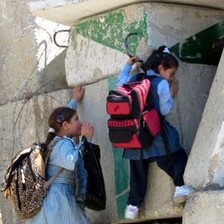The Electronic Intifada 10 May 2006
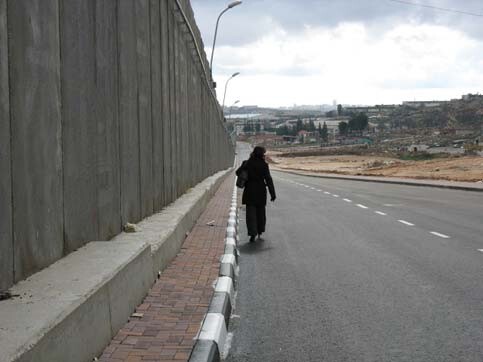
A Palestinian walks alongside the separation wall in Al-Ram in January 2006. (Dania H. Yousef)
“The laborer who has children, has a house, has a family is forced to work not only on the Wall—if they told him to come work with their [Israeli] security he would—because he wants to feed his children; there is no one else to take care of them.”
-Anonymous Palestinian worker on the Israeli Separation Wall[1]
As the political and military conflict between Palestinians and Israelis wages on, it is the average citizen who has been besieged by harsh realities that have made survival all too difficult. One faction of people who have been left to clamor for economic endurance is the Palestinian laborers. The hardships faced under occupation, systemic closures, the Palestinian Authority’s (PA) history of corruption, and lack of employment opportunities in the Occupied Palestinian Territories (OPT) have led many to seek employment on the Israeli Separation Wall. In most instances, they have no other option but to work on a structure they, themselves, view as harmful to their futures.
In June of 2002, the Israeli government approved plans to initiate the construction of a $3.4 billion separation barrier that, it stated, would prevent the uncontrolled entry of Palestinians into Israel. The government initially proclaimed that the Wall would follow the Green Line; which is only 192 miles long; making a nearly 500 mile long structure seem unfounded. By taking a compendious glance at what the structure will achieve, one becomes fascinated and puzzled by how the Palestinian people can participate in its creation, fully knowing, as stated by the International Court of Justice (ICJ), that it “severely impedes the exercise by the Palestinian people of its right to self-determination…”[2]
On September 13, 1993, the signing of the Declaration of Principles by the Palestine Liberation Organization (PLO) and the government of Israel brought with it not only the hope of peace to the war-ridden region, but of economic rejuvenation for the Palestinian people. Of the few clauses in the Oslo Accords that actually intended to improve the Palestinian economy, all were stalled by Israel’s systemic pattern of closures. Between 1992 and 1996 the real per capita GNP dropped 37 percent, as the unemployment rate tripled from 11 percent to 29 percent. In addition, between 1995 and 1997 the Palestinian poverty level rose from 20 percent to 40 percent, creating a crisis that would only worsen with the eruption of the Al Aqsa Intifada in September of 2000 as Israel’s closure patterns were tightened.
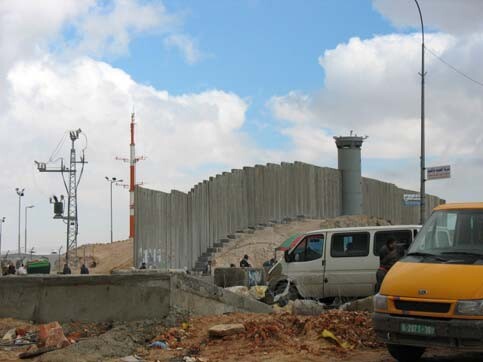
Vans carrying Palestinian passengers stop alongside the separation wall as passengers disembark at the Kalandia checkpoint in January 2006. (Dania H. Yousef)
The complexity of Israel’s closure policy is that it is constantly being redefined for economic rather than security reasons. Israel implemented a policy that eased permit restrictions on workers building the settlements (and eventually the Wall). Single men under the age of 28 were issued permits, traits that otherwise prohibit you from receiving authorization to work inside the Green Line. The Palestinian areas were transformed into “de facto labor reserves out of which Palestinians cannot easily exit without a permit issued by the Israeli authorities…The ‘Bantustanization’ process became entrenched with the Oslo agreements through the handling of three key elements central to the future of Palestinian labor movements: territorial control, Palestinian workers’ access to Israel, and the development of Israeli settlements in the West Bank and Gaza Strip.”[3]
The stigma associated with any Palestinian aiding the Israeli government with the construction of the Wall has caused many to do so clandestinely for fear of repercussions from their communities and political factions. The lack of action taken by the PA to remedy the economic situation only encouraged more Palestinians to agree to such work. Jamal Juma’, Director of the Stopthewall Campaign, asserts that the PA is not campaigning strongly enough against “those working on the Wall. They can do this by providing financial security for them. In other words, they can get paid for not working on the Wall. They should also make arrangements with the Palestinian companies that are collaborating with Israel on the Wall to ensure that they stop.”[4] Juma’ is referring to the Egypt “cement-gate” scandal where companies owned by PA ministers allegedly sold cement received from Egypt at twice the rate to an Israeli company, which then supplied it to construction companies building the Wall.
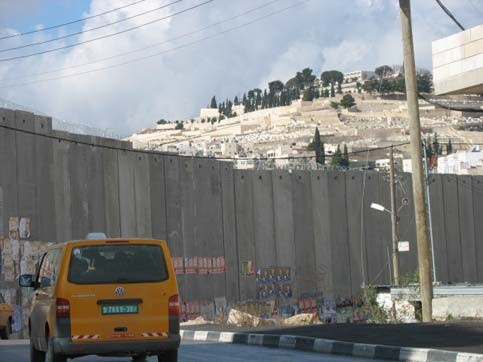
A van carrying passengers drives alongside the separation wall in Abu Dis in January 2006. (Dania H. Yousef)
As the Wall continues to “cantonize” the Palestinian population, their sense of Palestinian identity begins to vanish. They are unable to unite under one cause as they had been in previous years. This can be attributed to many things, namely the frustration felt under occupation, the lack of trust in their government and the spatial boundaries that have been created. This clearly shows that the divisions are affecting the entire Palestinian population. The factionalism has surged, especially in Gaza, as the military wings of political parties continue to clash on the streets in an attempt to gain dominance after Israel’s “withdrawal.” The fragmentation within the late Yasser Arafat’s Fatah party became more clearly defined with his passing in November of 2004 when the young Fatah supporters began challenging the older generation’s system of corruption, nepotism and political beliefs. It is apparent that familial responsibility took precedence over any form of nationalistic obligation. As it becomes more difficult for people to feed their families, they no longer bare a responsibility to their country, but rather to their family’s welfare. Thus it becomes acceptable to work for Israelis if the end result is ensuring your family is fed. The divisions in Palestinian society only increase the lack of national distinctiveness, therefore infusing an individual sphere, which can only assist Israel’s expansionist inclinations.
The laborers that were interviewed had reached a point of desperation that negated their national identity. They no longer viewed themselves as Palestinians fighting for autonomy, but rather as fathers fighting to feed their families. As research was conducted on the political and economic circumstances surrounding their situations, it became painfully clear that they were victims of an intricate political game between the PA and the Israeli government. The coupling of Palestinian corruption with Israeli occupation created an atmosphere that made it nearly impossible to survive economically. The strict closures, lack of job opportunities in the OPT, and the misallocation of foreign aid created a divided Palestinian society that placed basic necessities as a priority over all other aspects of life; including independence. The Oslo Accords proved to be a detrimental phase, leading the Palestinian laborers to once again turn to Israel for employment, only this time it was on the Wall. As Palestinians begin this new phase with an internationally rejected Hamas at the forefront, it seems plausible to ascertain that the situation of the laborers will remain stagnant, thus requiring them to continue with their socially detrimental employment.
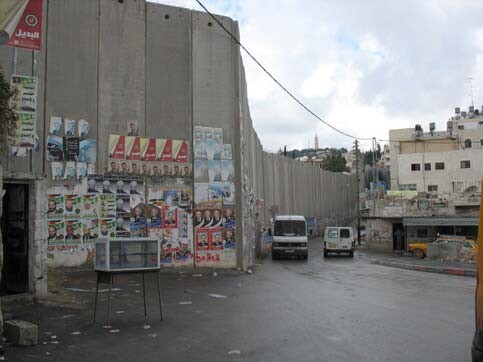
Posters cover the separation wall in Abu Dis in January 2006. (Dania H. Yousef)
The problem lies with both the Palestinian and Israeli governments. Their political maneuverings have left an entire population without the means to survive. The Palestinian laborers who are constructing this Wall are building a structure that has and will continue to disrupt the livelihoods of all Palestinians; yet, they cannot be blamed for wanting to provide for their families. As “Hussein” simply stated, “For as long as these people didn’t have any other choice and were victimized, what’s better for them: to eat or starve?”[5] Circumstances are dictating that in order to endure they have to participate in the constructions of barriers on their own freedoms, but can such barriers be realized when their very own struggle is marginalized? Prior to his participation in building the Wall, “Hussein” had a view of all of Jerusalem, but he now says, “I used to have friends in the United Nation who used to come here on my patio and tell me that I was living in a cinema for free. ‘You are living in a cinema for free.’ After a while, one of them came and told me you are hated. ‘Look at your view.’ Now, this is the only house in the entire area that is closed off on two sides. The sun, sometimes, we don’t see it.”[6]
Dania Harbi Yousef is a 25-year old Palestinian-American, born to parents from the village of Deir Yassin, who lived in the OPT during the first Intifada, and most recently from 2001-2003 covering the Al Aqsa Intifada with Al Jazeera and Al Arabiya News. She currently resides in Washington, D.C.
[1]Hussein, in person interview by author, 17 January 2006.
[2]ICJ Advisory opinion
[3]Farsakh, Leila. “Palestinian Labor Flows to the Israeli Economy: A Finished Story?,” Journal of Palestine Studies, Vol. 32, No. 1, (Autumn 2002), 14-15.
[4]Jamal Juma’, in person interview by author, 14 January 2006.
[5]Hussein, in person interview by author, 17 January 2006.
[6]Hussein, in person interview by author, 17 January 2006.
Related Links

